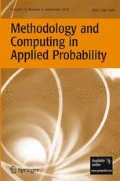Abstract
Adverse events in Phase II comparative clinical trials have received limited attention in the literature. Bersimis et al. (Stat Med 34:197–214, 2014) in proposed a class of comparative sequential designs with bivariate endpoints, where as a special case, the termination of the clinical trial due to the occurrence of a severe adverse event is treated. In this paper, using the Markov chain embedding technique, we extend this class of designs proposing two new designs, which treat cases where the development of an adverse event does not immediately stop the clinical trial, but penalizes appropriately the treatment that caused it. In both designs the penalty can be chosen either by assessing the severity of the adverse event or by optimizing the power. The numerical results show an excellent performance, achieving small expected sample sizes in conjunction with large values for power, satisfying in this way the ethical requirement for small sample sizes and fast decisions in clinical practice. The formulation of the procedure as a stochastic process is elegantly accomplished while it offers the necessary mathematical framework for further generalizing the designs covering more cases such as group sequential designs, etc.
Similar content being viewed by others
References
Armitage P, Berry G, Matthews JNS (2002) Statistical methods in medical research. 4nd Ed., Blackell Science Ltd
Balakrishnan N, Koutras MV (2002) Runs and scans with applications. Wiley, New York
Balakrishnan N, Bersimis S, Koutras MV (2009) Run and frequency quota rules in process monitoring and acceptance sampling. J Qual Technol 41(1):66–81
Bending JJ, Pickup JC, Keen H (1985) Frequency of diabetic ketoacidosis and hypoglycemic coma during treatment with continuous subcutaneous insulin infusion. Audit of medical care. Am J Med 79(6):685–691
Bersimis S, Sachlas A, Papaioannou T (2014) Flexible designs for phase II comparative clinical trials involving two response variables. Stat Med 34:197–214
Bradnock B, Law HT, Roscoe K (1995) A quantitative comparative assessment of the immediate response to high frequency ultrasound and low frequency ultrasound (‘Longwave therapy’) in the treatment of acute ankle sprains. Physiotherapy 82(2):78–84
Figueroa JJ, Basford JR, Low PA (2010) Preventing and treating orthostatic hypotension as easy as A, B, C. Cleveland Clin J Med 77:298–306
Glaz J, Naus J, Wallenstein S (2001) Scan statistics. Springer, New York
Herrmann N, Szatrowski TH (1982) Small sample properties of asymptotic formulas for expected sample size savings in curtailed binomial tests. Commun Stat C 1:221–245
Herrmann N, Szatrowski TH (1985) Curtailed binomial sampling procedures for clinical trials with paired data. Control Clin Trials 6:25–37
Kim K, Tsiatis AA (1990) Study duration for clinical trials with survival response and early stopping rule. Biometrics 46(1):81–92
Kim K, DeMets DL (1992) Sample size determination for group sequential clinical trials with immediate response. Stat Med 11:1391–1399
Kunz CU, Kieser M (2012) Curtailment in single-arm two-stage phase II oncology trials. Biom J 54(4):445–456
Lan KKG, DeMets DL (1983) Discrete sequential boundaries for clinical trials. Biometrika 70:659–663
Lan KKG, DeMets DL (1989) Changing frequency of interim analysis in sequential monitoring. Biometrics 45:1017–1020
Leitch JW, Klein GJ, Yee R, Leather RA, Kim YH (1991) Syncope associated with supraventricular tachycardia. an expression of tachycardia rate or vasomotor response?. Circulation 85:1064–1071
Lou WYW (1996) On runs and longest run tests: a method of finite Markov chain embedding. J Am Stat Assoc 91(436):1595–1601
Lu Y, Jin H, Lamborn KR (2005) A design of phase II cancer trials using total and complete response endpoints. Stat Med 24:3155–3170
O’Brien PC, Fleming TR (1979) A multiple testing procedure for clinical trials. Biometrics 35:549–556
O’Connor PW, Li D, Freedman MS, Bar-Or A, Rice GPA, Confavreux C, Paty DW, Stewart JA, Scheyer R (2006) A Phase II study of the safety and efficacy of teriflunomide in multiple sclerosis with relapses. Neurology 66:894–900
Pocock SJ (1977) Group sequential methods in the design and analysis of clinical trials. Biometrika 64:191–199
Pryseley A, Tilahun A, Alonso A, Molenberghs G (2010) Using earlier measures in a longitudinal sequence as potential surrogate for a later one. Comput Stat Data Anal 54:1342–1354
Salvan A (1990) Planning sequential clinical trials: a review. Comput Stat Data Anal 9:47–56
Solomon MJ, Young CJ, Eyers AA, Roberts RA (2002) Randomized clinical trial of laparoscopic versus open abdominal rectopexy for rectal prolapse. Br J Surg 89:35–39
Suffoletto MS, Dohi K, Cannesson M, Saba S, Gorcsan J (2006) Novel Speckle-tracking radial strain from routine black-and-white echocardiographic images to quantify dyssynchrony and predict response to cardiac resynchronization therapy. Circulation 113:960–968
Thall PF, Cheng SC (1999) Treatment comparisons based on two-dimensional safety and efficacy alternatives in oncology trials. Biometrics 55:746–753
Thall PF, Wooten LH, Shpall EJ (2006) A geometric approach to comparing treatments for rapidly fatal diseases. Biometrics 62:193–201
Yamanaka R, Abe T, Yajima N, Tsuchiya N, Homma J, Kobayashi T, Narita M, Takahashi M, Tanaka R (2003) Vaccination of recurrent glioma patients with tumour lysate-pulsed dendritic cells elicits immune responses: results of a clinical phase I/II trial. Br J Cancer 89:1172–1179
Acknowledgements
S. Bersimis and A. Sachlas are supported by the Greek General Secretariat for Research and Technology research funding action “ARISTEIA II”. The authors would like to thank the Associate Editor and the two anonymous referees for their constructive comments that helped them to improve the manuscript.
Author information
Authors and Affiliations
Corresponding author
Rights and permissions
About this article
Cite this article
Bersimis, S., Sachlas, A. & Papaioannou, T. Monitoring Phase II Comparative Clinical Trials with Two Endpoints and Penalty for Adverse Events. Methodol Comput Appl Probab 20, 719–738 (2018). https://doi.org/10.1007/s11009-017-9582-3
Received:
Revised:
Accepted:
Published:
Issue Date:
DOI: https://doi.org/10.1007/s11009-017-9582-3
Keywords
- Bivariate sequences of trials
- Clinical trials involving two binary endpoints
- Markov chain embeddable random variables
- Phase II clinical trials
- Decision rules
- Waiting time distribution
- Adverse events
- Penalization




